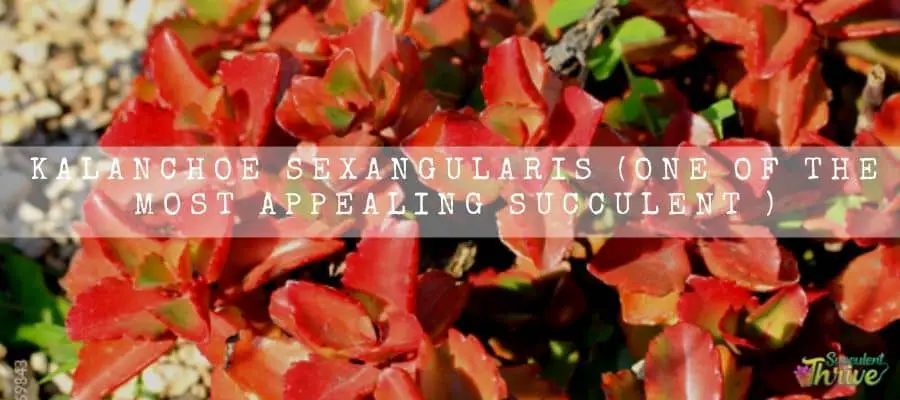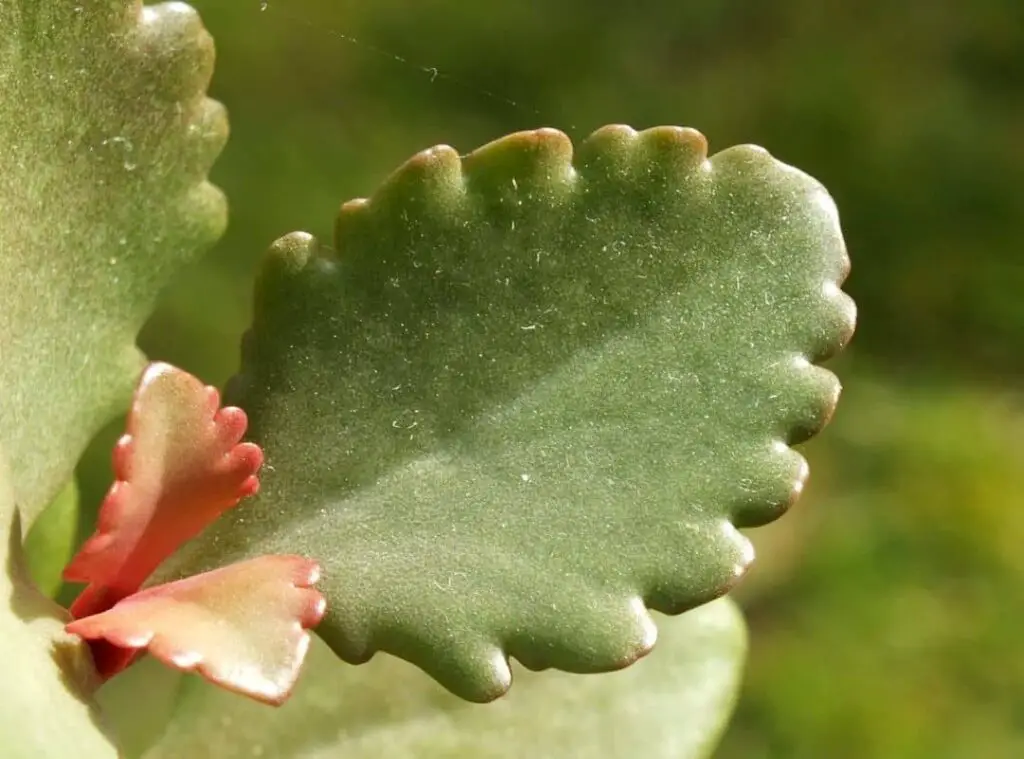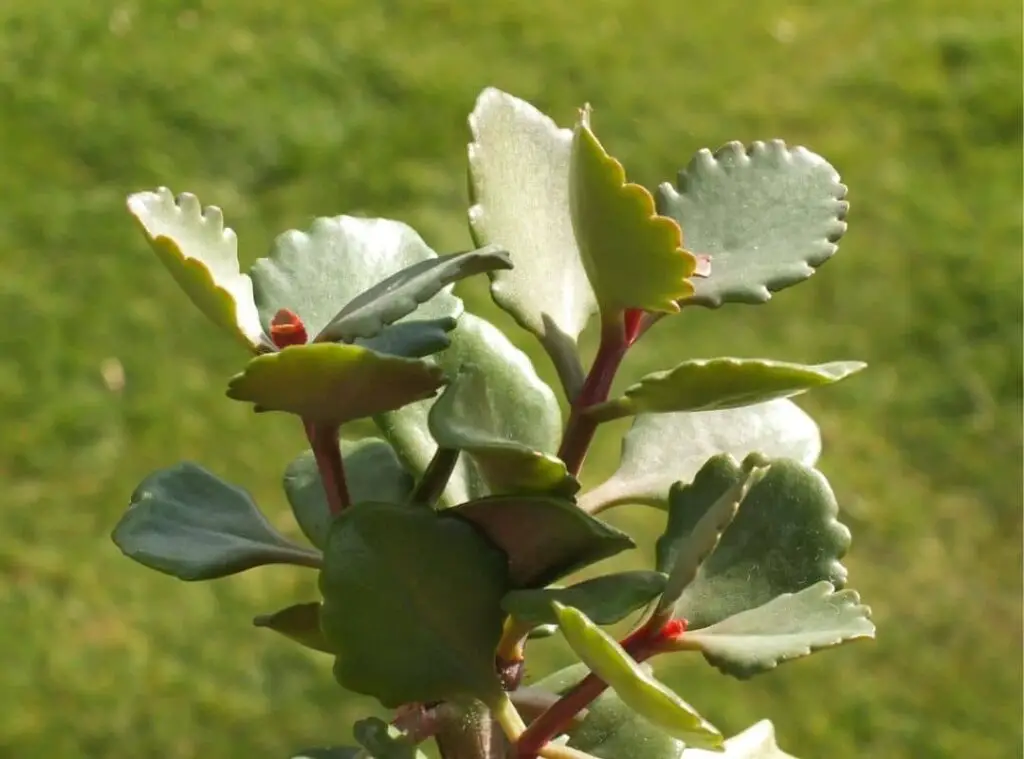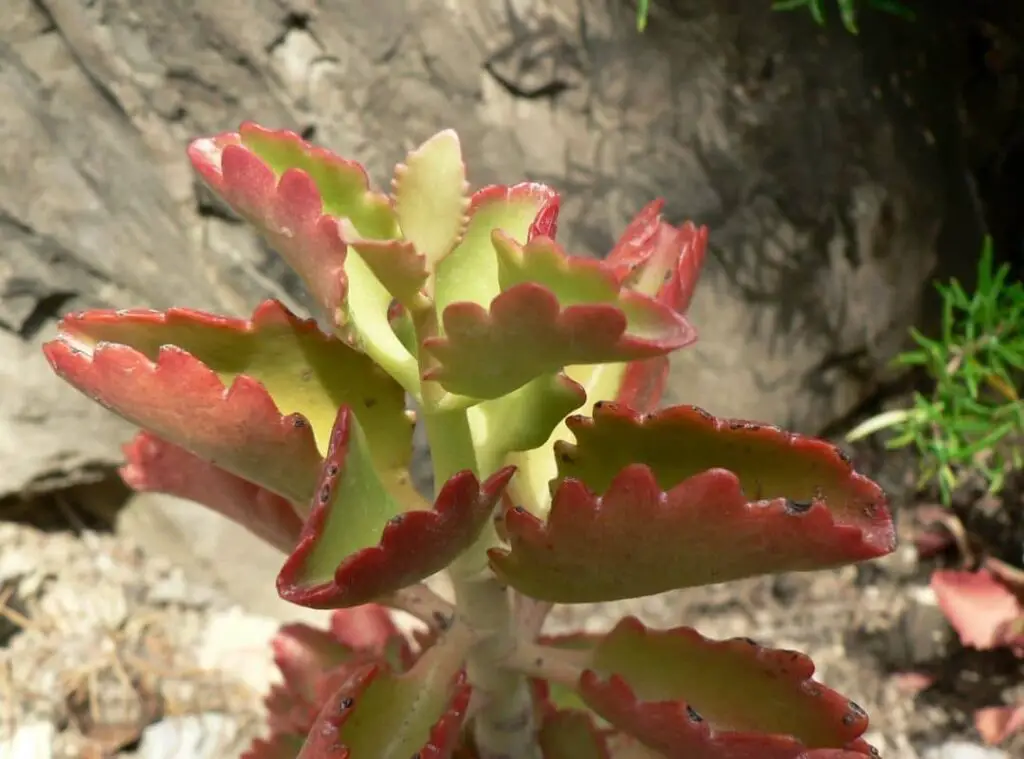Kalanchoe sexangularis plants are hardy and evergreen plants. They are also renowned as decorative plants.
Many gardeners tend to grow these plants due to the appealing characters they have in their red foliage. Rock gardens and patios would be their natural habitats.
They are somewhat different to other succulents since they can thrive in partial shade as well.
One more interesting characteristic of these plants is their bloom. Their flowers are quite attractive towards pollinators such as butterflies and bees.
Not only that but also, their easy maintenance is one more reason for you to have these plants. If you are a forgetful gardener, you could consider growing the Kalanchoe sexangularis plants.
Bushveld Kalanchoe, red leaved kalanchoe, six angled Kalanchoe are some of the common names of Kalanchoe sexangularis plants.
If I briefly touch on their origin, they are endemic plants to South Africa. Further you would commonly find them in countries such as Swaziland, Zimbabwe as well.

How do I identify kalanchoe sexangularis?
Kalanchoe sexangularis plants usually grow in an upright manner. They would consist of stems which are more squared or ridged.
When they are immature you could spot them in green. When they mature, you could spot them turning brown in color.
Further they would be flaky as well. Kalanchoe sexangularis plants’ leaves could enlarge and consequently their stem could become lax and droopy and lie around the ground.
They would rise to about 1.5 m in height. Kalanchoe sexangularis plants usually grow in a spreading manner and they can spread in a large area as well.
Kalanchoe sexangularis leaves are broad, elliptical. Further they would be glossy and serrated as well.
The sizes of the leaves would be 50-120 mm in length. They would consist of scalloped leaf tips too.They would come up with red tinges.
If you grow them whilst exposing them to shape, the leaves of the Kalanchoe sexangularis plants would be green and red.
However, when you grow them in full sunlight, they will turn ruby red. On the other hand, they would turn red during cooler months as well.
Sizeof the plant
Kalanchoe sexangularis plants grow up to 1.5 m in height. Further the leaf length would be 50-120mm.
Growth rate
Kalanchoe sexangularis plants grow at a rapid rate and tend to show a spreading growth pattern as well.
One look care guide
| Botanical Name | Kalanchoe sexangularis |
| Common Name | Bushveld Kalanchoe, red leaved kalanchoe, six angled Kalanchoe |
| Plant Type | Succulent |
| Mature Size | 1.5 m in height. |
| Sun Exposure | Full sunlight to partial shade |
| Soil Type | Well-draining sandy |
| Soil pH | 5.0-6.0 acidic to neutral |
| Bloom Time | Spring |
| Flower Color | Yellow |
| Hardiness Zones | USDA hardiness zones 9a-11b (20 degrees Fahrenheit – 50 degrees Fahrenheit). |
| Native Area | South Africa |
| Toxicity | Toxic for pets |
| Average price | USD 7 |
How do you take care of kalanchoe sexangularis?
Light Requirement
As aforesaid, Kalanchoe sexangularis plants prefer to have full sunlight. Having said that, they could also perform well in partial shade too.
If you have grown them as outdoor plants, go ahead with a spot where they can receive both full sunlight and partial shade.
It is crucial to provide sufficient sunlight levels to have vigorous growth in the Kalanchoe sexangularis plants. If you grow them as houseplants, you could consider growing them closer to bright sunny window spots.
Do not ever leave them in direct sunlight as it will be too harsh for them.
If you grow them indoors and if you live in cooler months, you need to grow them outdoors during spring and early summer.
However, when you bring them outdoors from indoors, ensure that you are slowly acclimating them without exposing them to full sunlight at once. If you fail to do it, it will create sunburns in the plants.
If you grow them as indoor plants throughout and if you wish to increase the light levels, you could consider growing them near grow lights.
You may use artificial lights such as fluorescent lights, incandescent bulbs. I advise you not to place the grow lights too close to the plants as the heat could burn them.

Temperature and humidity
Kalanchoe sexangularis plants require warmer temperatures to perform well.
They do not handle cold weather conditions well. 20 degrees Fahrenheit is the minimum temperature they can withstand.
If you expose them to less temperatures than them, it will create frost damages for the plants. when it comes to right humidity levels, they prefer to have dry to moderate humidity levels.
Is it cold hardy?
Kalanchoe sexangularis plants are not frost hardy plants.
USDA Hardiness Zone
Kalanchoe sexangularis plants prefer to grow in USDA hardiness zones 9a-11b (20 degrees Fahrenheit – 50 degrees Fahrenheit).
Watering Requirement
Kalanchoe sexangularis plants grow in hot and dry weather conditions. Hence, they require only minimal watering.
Ensure that you water them deeply and no excess water is remaining in the soil after watering them.
If you want to ascertain whether the soil is dry or not, you could simply place your finger in the soil and check and see whether it is dry or soggy.
Do not ever over water the Kalanchoe sexangularis plants as it could create severe repercussions on the well being of the Kalanchoe sexangularis plants.
Once you finish watering the Kalanchoe sexangularis plants, always check whether there is any moisture retaining in the pot or whether it is dry.
You should water them more frequently in summer and spring and cut them back in during winter and fall.
Soil Requirement Type / pH
Kalanchoe sexangularis plants thrive in an acidic to neutral soil mix and the ideal ph. should be 5.0-7.0.
In addition to that, the most crucial factor of the right soil mix of the Kalanchoe sexangularis plants is to have good drainage.
Easiest is to grow them in a succulent soil mix or in a cactus soil mix which you could purchase from the stores.
Alternatively, you could make a soil mix on your own by blending 40 & – 50 % sand, peat moss and with regular potting mix.
Pot size Potting and Repotting
I recommend growing Kalanchoe sexangularis plants in terracotta pots and in clay pots since they are made of porous materials.
When you grow these plants in porous materials, it ensures that the moisture within the pot is evaporating faster.
When it comes to reporting, it is not important to do it on a frequent basis. However, I encourage you to report the plants every couple of years.
When you repot them. It will allow the plants to grow in a fresh growing medium.
Consequently, they can gain fresh nutrients as well. You need to consider repotting them when you freshly purchase them from nurseries.
Apart from that, if there have been any pest infection, repotting the plants could be very handy.
Where to Plant
When selecting a spot to grow the Kalanchoe sexangularis plants, you should always go ahead with a place where they can gain strong sunlight levels.
Select a bright sunny spot in your garden when you grow them as outdoor plants. well. Further grow them in a porous material as explained above.

Fertilizer and time of year
Kalanchoe sexangularis plants do not require a lot of fertilizers. They can thrive well with the nutrients available in their growing medium.
However, if you still wish to feed them, you could consider feeding them once every fortnight or once a month. Try using a manufacturer recommended fertilizer. Do not feed them during their dormancy.
Dormancy
Kalanchoe sexangularis plants go dormant in winter.
Other plants Pairs Well With
Kalanchoe longiflora, Cotyledon orbiculata, Oscularia deltoides, Curios crassulifolius would grow well with these plants, In addition to that they could grow well with plants which have gray foliage as well.
Toxicity
Kalanchoe sexangularis plants could be poisonous for pets’ cattle and for birds too. However, they are human friendly.
Having said that, you need to take necessary actions to keep them away from the kids.
Flowering
Kalanchoe sexangularis plants produce flowers in yellow.
Their flowering season would be spring, and it would be so pleasing to watch them in full blossom, and they would look lovely if you have grown them in containers or in the gardens.
Read our article on Kalanchoe sexangularis flower article.
Common bugs and illnesses
Kalanchoe sexangularis plants are usually resistant to pests’ attacks and to diseases. Having said that they could suffer from aphids, mealybugs, and from scales on and off.
To remedy them, you could simply rub the plant with alcohol. Alternatively, you could use neem oil or an insecticidal spray for them too.
Apart from that you need to be mindful to not over water them since that would create disease such as root rot. It could further encourage fungal growth and other infections as well.
Special Care tips
You could consider pruning the matured plants since that will help you to keep the plants tidy and neat.
Further, it will ensure a healthy growth of the plants too. in addition to that do not forget to remove the dead leaves and the spent blooms as well

How to propagate kalanchoe sexangularis
You could use leaves, stem cuttings to propagate the Kalanchoe sexangularis plants. If you wish to use the leaf and the stem cuttings, take a clean scissor and take them off from the mother plant.
You could obtain them at any time of the year. Once you obtain these, you could place them in a dry place where they can be callous.
Next, you could place them in a container which you have filled with a succulent soil mix. Ensure that the soil mix is pre moistened.
After that you could place the cuttings in the specimen and ensure that you mist them several times a day.
Place the specimen in a spot where they can gain indirect sunlight and not direct sunlight. It would take about two to three weeks to form roots.
kalanchoe sexangularis plant benefits
They would be handy to use in succulent gardens. Moreover, you could use them in rockeries, borders and in bed plantings too.
You could use them as container plants as well. They are quite effective for both indoor and outdoor gardening.
Conclusion
Trust you found this article very useful, and you were able to improve your knowledge on how to take care of them well.
As you may realize Kalanchoe sexangularis plants are such attractive plants and it is very easy to maintain them too.
So why wait, hurry up, grab your Kalanchoe sexangularis plant and start growing them.
Read Next : Kalanchoe Rhombopilosa Care | 16 Care Secrets You Should Know | Kalanchoe Albino Succulent | 11 Amazing Care Tips For You | Kalanchoe Tomentosa Varieties | 7 Super Cute Plants With More Facts |


